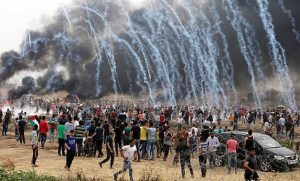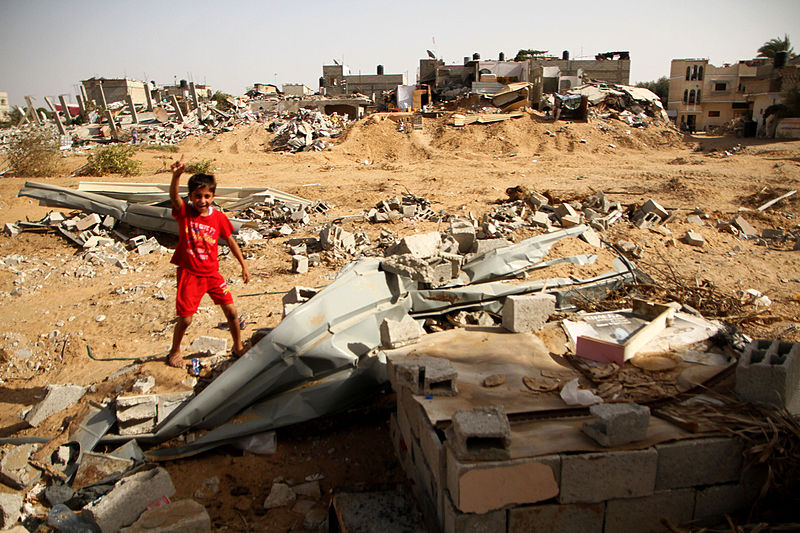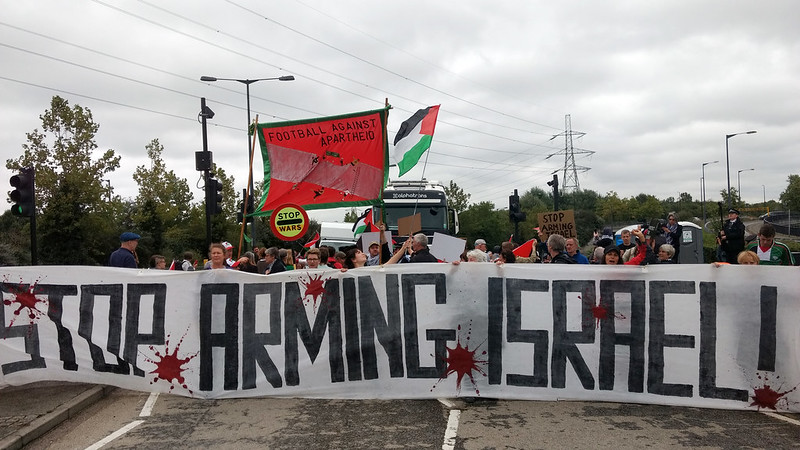Israel maintains a regime of institutionalised apartheid against Palestinians in the Occupied Palestinian Territories of the West Bank and Gaza, as well as a deepening system of institutionalised discrimination within Israel itself, which reduces Palestinian Israelis to the status of 2nd-class citizens. The situation in Israel, the West Bank, and Gaza, has only worsened since the publication of the Arming Apartheid report.
According to the Israeli human rights organisation B’Tselem, Israel has gradually created two separate regimes in the West Bank, dependent on national identity: one for settlers and the other for Palestinians. The settlers enjoy all the rights granted to citizens of a democratic country. In contrast, Palestinians live under a harsh military rule which primarily serves the interests of Israel and the settlers. A powerful example of this system was the opening early in 2019 of an “Apartheid road” east of Jerusalem, with a wall down the middle: one side of the road is for Israeli settlers, the other for West Bank Palestinians. The Israeli government began moves towards further immoral and illegal annexation of the West Bank in June 2020.
Israel has held the Gaza Strip under siege since 2007, effectively imprisoning the Palestinian population of Gaza, and limiting their supply of essential goods such as food, medicines and construction material. Largely as a result of this, around 1.3 million people in Gaza, out of a population of 1.8 million, were food insecure in 2018. In October 2018, a UN Special Rapporteur warned that, facing 70% youth unemployment, widely contaminated drinking water, and a collapsed healthcare system, Gaza could become ‘unliveable’ by 2020.
Controlling Palestinian lives, demolishing Palestinian homes
This situation is maintained by a system of over 500 military-controlled checkpoints, barriers and gates. These restrictions, combined with Israel’s control of 80% of water resources in the Occupied Palestinian Territories, have stunted the growth of the Palestinian economy, as well as dramatically impacting the day-to-day lives of Palestinians living there. On top of this is the “Apartheid Wall” which Israel began constructing through the Occupied West Bank in 2002, purportedly to prevent terrorist attacks, but in reality enclosing its major settlements and dividing Palestinian land.
Israel regularly demolishes Palestinian houses, schools, and other structures in the Occupied West Bank. From 2006 to 2020, Israel has demolished 2,216 Palestinian homes in the West Bank (including East Jerusalem), leaving 5,685 people homeless. As of now, the village of Khan al-Ahmar in the West Bank remains under imminent threat of demolition, following approval by the Israeli High Court in September 2018. The demolition would make way for further illegal settlement construction which would effectively cut the West Bank in two. Massive local protests combined with widespread international criticism led to Israel postponing the demolition in October 2018, but Israel is still seeking ways to remove the villagers.
The most recent escalation by Israel in East Jerusalem and Gaza was triggered by the planned expulsion of 6 Palestinian families, 58 people, from their homes in the Sheikh Jarrah neighbourhood of the city, to make way for Israeli settlers. Massive Palestinian protests against these planned expulsions have been met with heavy repression by Israeli forces, culminating in the violent storming of the Al Aqsa Mosque on three successive days in May 2021, injuring hundreds of worshippers.
The “Nation State” law
Regarding the situation in Israel itself, i.e. within Israel’s internationally-recognized borders inside the “Green Line”, not including the West Bank and East Jerusalem, Israel passed a “Nation State” law in July 2018 that declared that “Israel is the historic homeland of the Jewish people and they have an exclusive right to national self-determination in it”. The law also removed the status of Arabic as an official language of Israel alongside Hebrew. It was widely criticised within and outside Israel, including by the EU, as deepening the status of Palestinian and other non-Jewish citizens of Israel as second-class citizens. While in the past Israel has claimed to afford Palestinian citizens of Israel equal treatment, there are over 65 laws that directly or indirectly against Palestinian citizens and/or residents of the Occupied West Bank.

Photo by UN Office for the Coordination of Humanitarian Affairs
The wars on Gaza and the Great March of Return
Over the past decade or so, Israel has carried out four devastating military assaults on the Occupied Gaza Strip, all of which have resulted in large numbers of civilian deaths and have been said to be in violation of international law:
Over 22 days beginning 27 December 2008, Operation Cast Lead resulted in 1,383 Palestinian deaths and left large areas of Gaza razed to the ground.
During Operation Pillar of Defence in November 2012, Israel carried out bomb and missile strikes on residential areas, including strikes that were disproportionate and caused heavy civilian casualties, leaving 174 Palestinians dead.
Less than two years later, 2,205 Palestinians, including 521 children, were killed during July 2014’s Operation Protective Edge. Over the course of the attack on Gaza, children in a UN refugee shelter were shelled while they slept, airstrikes hit schools, a hospital and a home for disabled people, while family homes were destroyed with the inhabitants inside and whole civilian neighbourhoods were levelled.
During 2018, Israeli forces killed 295 Palestinians in the West Bank and Gaza, and injured 29,000. Of these, 180 deaths and over 23,000 injuries occurred during the Great March of Return, a series of popular protests in Gaza at the border fence with Israel marking 70 years since ‘Al Nakba’ (the catastrophe), the mass expulsion of Palestinians from what became Israel in 1948. The protests were repeatedly met with live fire from Israeli forces. 57 of those killed and over 7,000 of those injured were children. According to the Gaza Health Ministry, 14,000 people were hospitalized during the Great March of Return, including 6,000 wounded by live fire. Three health workers were killed in the protests, and 546 wounded. The worst incident in the Great March of Return occurred on May 14th 2019, when Israeli forces massacred 60 unarmed Palestinian protesters and wounded more than 1,300. There is no evidence that any of those killed during the protests were armed.
Most recently, following the events in East Jerusalem described above, rocket fire by Hamas in response to Israel’s actions in Jerusalem was met with a fourth major air and ground assault beginning in May 2021. At the time of writing (18 May), at least 217 people have been killed in Gaza by Israeli attacks, including 63 children, while 12 people have been killed in Israel, including 2 children, by rocket fire from Palestinian groups in Gaza.




